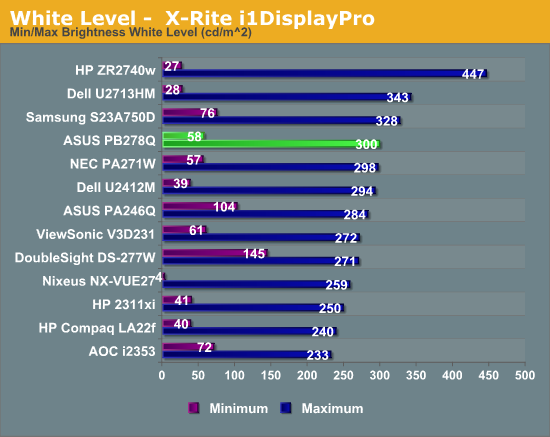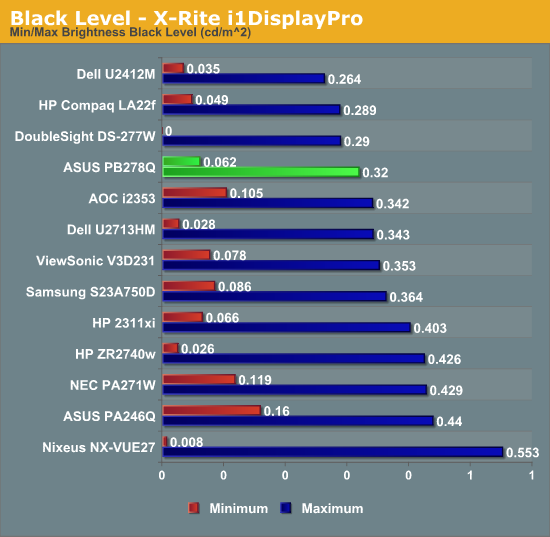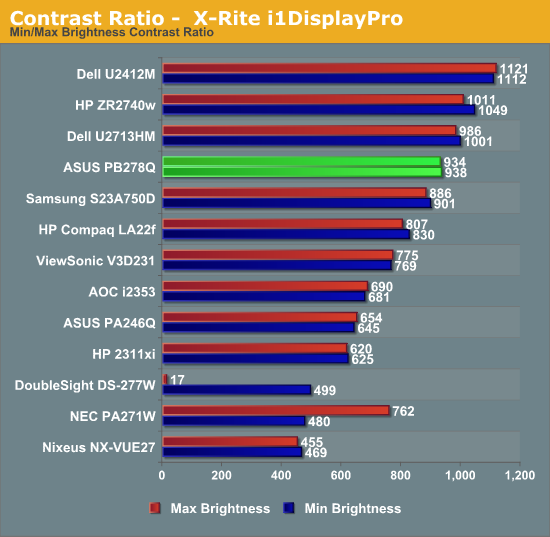ASUS PB278Q Review: An IPS Competitor Emerges
by Chris Heinonen on November 19, 2012 11:00 PM ESTASUS PB278Q Brightness and Contrast
ASUS says that the PB278Q can do 300 nits at maximum brightness, and that spec hits it right on the head. With a full white screen and the brightness pushed up all the way, I got exactly 300 nits of light output from the display. One of PLS' advantages over IPS is supposed to be the ability to let more light through, though this number is very close to what other 27” displays achieve. It might be able to do this using a lower powered LED backlight, and we will test that out in power usage later to see if that is the case.
With the brightness at minimum, we get 58 nits of brightness which should be low enough for virtually every user. The lowest that most users might set a display to is probably 80 nits, and so as long as a display goes below that level I think that is a perfectly acceptable minimum brightness level. This range from 58 to 300 should also accommodate virtually all users for their brightness requirements.

Before measuring the black level, I made sure to disable dynamic contrast, as it would likely just disable the LED backlight and give a result of 0 for a black screen. Since no one really uses an all black screen in this way, I don’t feel that testing it is appropriate. With the backlight at maximum the black level was 0.32 nits, and at minimum it was down to 0.062 nits. This is a decent minimum black level for a display, and good for IPS, but not as exceptional as some displays can manage.

The black level looks better when used to calculate the contrast ratio of the display here. With a contrast ratio right around 935, this is right around what we see for other 27” IPS displays. The PLS display seems to be equal to what other IPS displays can manage, not really much better or worse, but right down the middle of the range.

Brightness and Contrast details are right in line with what we expect from an IPS display, and since PLS is very similar to IPS we see very similar results. The peak brightness is lower than some IPS displays, but most people don’t use more than 300 nits and we will see later if this enabled ASUS to use a lower power backlight.










55 Comments
View All Comments
wtg2424 - Tuesday, November 20, 2012 - link
Not in the US their notlowlymarine - Tuesday, November 20, 2012 - link
Setting aside my desire to slap you for your abuse of the English language, yes they definitely are:http://accessories.ap.dell.com/sna/productdetail.a...
MrSpadge - Tuesday, November 20, 2012 - link
Hurt me as well.. and I'm not a native speaker.steveotron - Tuesday, November 20, 2012 - link
That's been the occasional sales price on Dell's Australia site. The U.S. site has not had a sale on the U2713HM yet (there were a few 10% coupons that worked).wtg2424 - Tuesday, November 20, 2012 - link
I did get mine for $715 plus a $35 gift card though so I'm not complaining. This thing is freaking awesome!!Peanutsrevenge - Tuesday, November 20, 2012 - link
Blah blah blah.Where are the next gen of monitors with ultra thin bezels like the apparent vaporware LG DM92?
We're in the era of multi monitors, where for many people bezel thickness isn't a major issue for work related stuff, but for others and especially gamers, the bezel just destroys the joy that could be had with multi-monitor gaming.
What is it that's holding back the next step? I just don't understand the issue given that we're seeing it at the extremes, phones and TVs.
Calista - Tuesday, November 20, 2012 - link
Myself I wonder when screens with higher pixel density will start to arrive. I don't expect higher resolution than 2560x1600 (no common interface to drive those resolutions exist today), but 2560x1600/1440 at maybe ~23-24" should be possible and very desirable. A 30" display is almost uncomfortable big.darkling - Tuesday, November 20, 2012 - link
Yes, I agree. I've been actively waiting for something like 2560x1600 at 24" with a refresh rate greater than 60hz--I know there are limitations with interfaces and RAMDAC, but maybe 85hz?Old_Fogie_Late_Bloomer - Tuesday, November 20, 2012 - link
Here's a third vote for 2560x1600 at 24". Also, wide gamut, please...haukionkannel - Tuesday, November 20, 2012 - link
Well... most likely the next step is 4k monitors, just because they have the same aspect ratio as "normal" HD displays...But when they are affordable I can not say. But at least these are better than normal 1080 displays... Not much, but there is the difference.